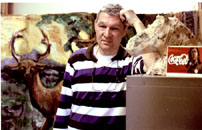
This is not the
work of a great artist, David Pariser says of a screen he painted at
15. On the other hand, the pop artwork by 19-year-old Chinese artist
Bin Wan, now residing in New York, shows a talent at work. “The only
thing we don’t know yet is if he is going become a great artist,” Pariser
said.
|
by Debbie Hum
Some of the childhood drawings by Picasso, Toulouse-Lautrec and Klee wouldn’t
even be chosen to grace the refrigerator at home, says David Pariser,
Professor in the Department of Art Education and Art Therapy.
In his previous research, Pariser has found nothing extraordinary about
the patterns of graphic development of recognized artists. As children,
they produced artwork that varied from the hackneyed to the remarkable.
Now Pariser, recently named a Fellow of the American Psychological Association
for his research, is continuing his investigations with two projects that
look at both sides of the issue of giftedness and artistic greatness:
How is art judged, and how do children develop in art?
“It is very difficult to tell who is going to become a great artist
and who is not,” Pariser said. “As the status of ‘great
artist’ is socially constructed, different cultures will have different
criteria for the same exalted role.”
That’s not to say that the designation “great” is completely
arbitrary, he added. “There may well be some common denominators
to greatness, but until we learn more about cross-cultural instances,
we can only guess at what the universal properties of artistic greatness
may be.”
The first project asks: By looking at their childhood work, can judges
distinguish the juvenilia of great artists from that of other gifted children?
In collaboration with Susan Rostan of Hofstra University and Howard Gruber
of Teacher’s College, both in New York City, Pariser is asking artist-judges
to distinguish between the drawings of children who are artistically gifted
and the juvenilia of known world-class artists.
The research is supported by a two-year grant from the Esther Katz Rosen
Foundation. The study uses actual juvenile work by great artists, and
looks at the question of identifying children destined for noteworthy
adult artistic performances in two cultures, North American and Chinese.
The researchers anticipate that regardless of the judges’ cultural
backgrounds, there will not be much difference in their ability to distinguish
the juvenile work of contemporary gifted children from that of great artists.
The second project, with Anna Kindler of the University of British Columbia
and Axel van de Berg of McGill University, asks: How do people from three
cultures (Brazil, Canada and Taiwan) rank the relative merits of child,
adolescent and adult artwork? It is supported by a three-year, $130,000
SSHRC grant, and builds upon a 1994 Spencer Foundation study by Pariser,
van den Berg and Jessica Davis of Harvard University that found strikingly
different assessments of the same set of drawings by judges from different
cultural backgrounds.
That study tested the viability of Howard Gardner’s notion of U-shaped
aesthetic development. Gardner’s theory “naturalizes” the
idea that little children are born artists, and that as they grow up,
most children lose their artistic originality and expressiveness —
save those who do become adult artists.
Davis, Pariser and Van Den Berg found that judges with a Western artistic
background concurred with Gardner’s perspective, and emphasized expressiveness
and originality when they ranked drawings, whereas judges with a traditional
Chinese background in the arts found no curve at all. They used technical
ability and mastery of style as their criteria for judging drawings.
The new study expands on the Spencer study by creating a much larger database
of drawings and using more judges, from Brazil, Canada and Taiwan. The
120 judges will rank and assess drawings by children and adults from all
three geographical regions. The research team expects that once again,
judges from different cultures will assess the drawings differently.
Aesthetic criteria within and across cultures are notoriously changeable,
Pariser said. For example, the drawings of contemporary Chinese children
tend to be technically far in advance of their North American age-mates,
but 19th-century North American children’s drawings rival the technical
excellence of contemporary Chinese children. This sort of shift is “one
more reason why it is so difficult to decipher the true path of children’s
graphic development, let alone children’s prospects for recognition
as great adult artists.”
Pariser, who joined Concordia in 1978, has written numerous articles,
essays and several book chapters outlining the special qualities of recognized
artists’ juvenile work and the work of gifted children. He has written
introductory essays to two books by Montreal painter and art educator
Yao Kui. Pariser is currently writing a book on children’s graphic
development for the Canadian Society for Education Through Art. .
|
|
|



